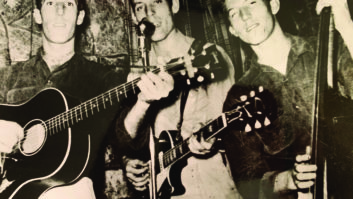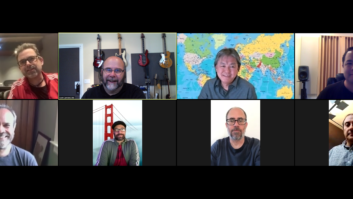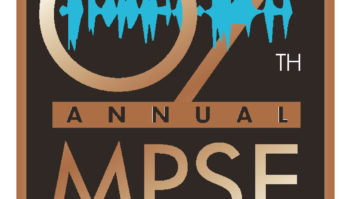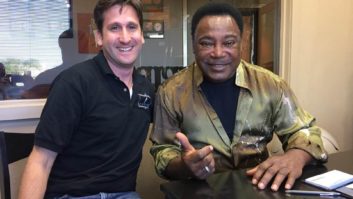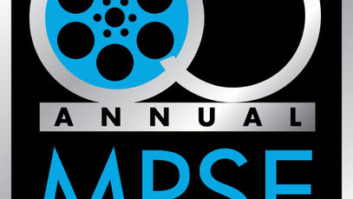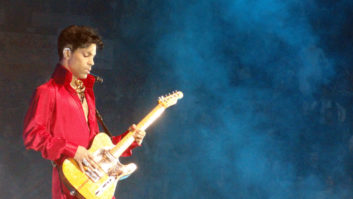Fourth of July weekend. It’s hot dogs and parades, flags and fireworks, and more often than not in recent years, the opening of a new movie starring Will Smith. This year, Smith brings in the Fourth with the hotly anticipated sequel to the 1997 action-comedy-sci-fi hit Men In Black. Remarkably, director Barry Sonnenfeld was able to bring back many of the key players who worked on the original, including principal actors Smith, Tommy Lee Jones and Rip Torn, production designer Bo Welch, composer Danny Elfman, supervising sound editor Skip Lievsay and production mixer Peter Kurland.
“From our point of view, it’s a rare opportunity to fix all the stuff that didn’t work in the first movie,” Lievsay says. “Almost every movie I’ve worked on, with maybe one or two exceptions, feels like a series of missed opportunities to me. I hate that about my job. It’s very exciting and creative, but there are always things that never get fixed or never get addressed, or both, usually for time or money reasons.”
Lievsay has had an extraordinary career as a first-call supervising sound editor operating out of New York (and now, bi-coastally). He has worked extensively with some of film’s great auteur directors, including multiple projects with the Coen Brothers, Spike Lee, Martin Scorsese, Jonathan Demme and Barry Sonnenfeld, as well as movies with Tim Burton, Robert Altman, John Sayles, Ed Burns and others. For more than a decade, Lievsay has spearheaded C5 Editorial, one of Manhattan’s leading post houses.
When it came time to make MIB2, Lievsay knew he’d be able to use some of the sonic environments and effects that he and others had created for the first film. In fact, he says, “At the outset, the picture department ordered copies of the FX masters from the first film. I’m happily allowing that. There was a lot to recycle; there are a lot of similar elements between the two films.
“There’s still a neuralizer [a gun that wipes out a person’s memory], but that’s an interesting example of how we went back and modified the sound be-cause we weren’t happy with how it turned out in the first movie. There were some high-frequency sounds that were made with a strobe flash as it recycles, and the particular sound recording we used had this high-frequency distortion that I didn’t like. So this time, Eugene [Gearty, sound designer] and I found another way to do that using the Synclavier. I’m sure no one will know the difference or care, but I do.”
Naturally, there are a number of new alien life forms that required creative sound generation, particularly the evil Serleena character, played by Lara Flynn Boyle. “All through the film, she has these snaky appendages that keep coming out,” Lievsay says, “and then near the end of the movie, she turns into a really big branchy, snaky thing. When she has these branchy things shooting out of her fingertips, we went with little Foley wooshy, whippy sort of sounds. But then she keeps changing through the movie and getting more snake-like, so we’re going with more gooshy, goopy sort of sounds. On one pass, they took the sound of some toy goop squishing between two hands. On another, they took tree branches, put them inside a rubber membrane and pushed that around and added some water. We did the usual dog-food-in-the-can noise. We did a very nice watermelon, too — we took it and ripped it and gushed the inside; very nice!” he adds with a laugh.
Lievsay likes to combine natural elements with electronic ones, and he’s always on the lookout for new gear. One of his recent favorites is a very retro-sounding analog synth that is “a new iteration of what is essentially a Buchla module from a company called Wiard — this guy from Milwaukee named Grant Richter makes them in his house. They’re very modular, old-fashioned patchboard-type analog synths. They use control voltage instead of MIDI; it’s ancient technology — it feels like Forbidden Planet all over again. In the film, there is a sense that some of this supposedly futuristic technology has been around for quite a while, and these sounds help to get that across to the audience. It also adds a little humor, we hope, which is definitely a part of these films.”
Lievsay and his cohorts have used network-based systems for many years, and he also notes that in the past, much of the sound work was done “direct to Avid, but we’ve been transitioning our effects department away from Avid onto Pro Tools, which is now a fact of life. Since Avid and Pro Tools aren’t compatible, our Avid work must either be saved as Pro Tools sessions or be laid off to some other kind of media.”
MIB2 utilized more than 850 CGI shots, so the sound team really had their work cut out for them. There was also more time and a bigger budget for the first film, so there was the predictable scramble when it came time for re-recording mixers Greg Russell and Kevin O’Connell at the Cary Grant Theater on the Sony lot this past spring. On a project like this, after the mad dash to the finish is complete, a neuralizer would really come in handy.
